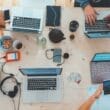Why Do I Feel Weird During Zoom Meetings?
Have you ever found yourself feeling exhausted or anxious after a long day of video calls? You’re not alone. With the rise of remote work and virtual communication, many people are experiencing what’s commonly known as “Zoom anxiety” – a feeling of stress, discomfort, or unease brought on by the constant use of video conferencing platforms like Zoom.
And while, Zoom anxiety can improve over time, it’s not always the case. Here’s A guide on how to tackle it and gain confidence during your virtual meetings.
What is Zoom Anxiety?
Zoom anxiety is the physical or mental feeling of distress caused by video conferencing.
Today, ‘Zoom,’ like ‘Google,’ is no longer just a noun. We can use it interchangeably with the act of video conferencing. So, ‘zoom fatigue’ is not specific to ‘Zoom’ but extends to similar tools like ‘teams,’ ‘skype,’ ‘meet,’ or ‘facetime.’
In a 2020 survey by a UK-based design agency, 73% of the respondents said they faced ‘Zoom Anxiety’ during the pandemic year. About 80% felt that technical problems during video calls and not knowing how to fix them caused distress. The survey also stated that the task of presenting on a video call was the most stressful.
Causes Of Zoom Anxiety
A study conducted by a Stanford researcher systematically deconstructs ‘Zoom fatigue’ from a psychological perspective.
Jeremy Bailenson, the author of the study, lists four reasons video chats cause anxiety and fatigue:
- Too much screen time.
- Seeing yourself constantly during video calls can be fatiguing.
- Video chats, unlike telephonic conversations, restrict our mobility.
- Unlike other forms of communication, video chats require much attention to understand non-verbal gestures and tone of voice.
8 Ways To Deal With Zoom Anxiety

1. Make Video Calls Interesting
You can control how the zoom meeting should go if you’re the organizer. Try and organize ‘ice-breaker’ sessions before the discussion starts. It will allow your team members to calm down and get comfortable.
If you’re only a participant, try and request the organizer or moderator to organize an ice-breaker.
Another way to make video calls enjoyable is by having fun stories at the start. You can talk about your weekend, your time with friends, or how bad the weather is at your place.
2. Keep Your Meetings Short
Zoom calls can be very draining as it requires a high level of attention. Long meetings increase fatigue. As a feedback loop, fatigue can increase anxiety in the next meeting.
Short meetings allow your team members to be at the best of their attention and keep them engaged. Moreover, when sessions are short, everyone looks forward to the next one.
3. Switch to 1-1 Sessions
If you’re a small company, you can switch to one-on-one meetings. It allows you to engage more clearly and reduce anxiety. You can be more confident with your teammates. Apart from this, 1-1 sessions will enable you to get to know your team members better.
However, if you’re in a large company, you can have micro-meetings with a maximum of 4 to 5 people. It is better than cramming 20 people into a grid view on your computer.
4. Practice Before a Presentation
Zoom presentations can be stressful. Like talking in a boardroom, zoom presentations involve talking in front of multiple people crammed in a grid. What makes it worse is that if some people choose to turn off their cameras, you’ve no way to figure out if they’re still listening or not.
To combat this problem, taking care of what’s in control is best. For the most part, our expression, speech, camera, and lighting are under our control. To bring out your best, it’s a good idea to do a mock presentation to yourself or a friend willing to listen.
5. Organize Online Games
Organizing games may not suit every occasion. If you’ve team members who appreciate some fun at the office, organizing online contests can be a good break from everyone’s busy schedule.
Games allow everyone to bond and talk to each other. Non-work-related conversations are something we all need once in a while.
6. Hide Self View
If you’re someone who has mirror anxiety, you can choose to change some of the settings on the app. Try to hide your self-view and see how that goes.
Make sure you look good only at the start of the meeting. Repeated checking only adds to the anxiety.
7. Identify The Source Of Your Anxiety
Anxiety can sometimes arise from your surroundings. An unwelcome visitor at your door, your pet or baby popping into the screen from nowhere, or your partner bursting into the room unannounced can become a source of anxiety.
While you cannot avoid some things like unwelcome visitors, you have control over other things. For example, if you’re worried about your partner barging into the room, you can tell them that you’d be in a meeting beforehand. Similarly, if you have a cat/dog, you can drop them in a safe place in another room.
8. Switch Off Video If It’s Unnecessary
Sometimes, videos are not required. If it’s one of those calls, feel free to switch them off. However, tell your teammates you’d be doing it. When you turn off your video, your anxiety levels reduce drastically.
How To Feel Confident In Virtual Meetings?
1. Smile Straight At The Camera
Look directly at the camera instead of your colleagues or your own image. To do this, you can follow some of our tips:
- Turn off self view on your screen-this way you will not constantly check how you look.
- Place something interesting above your webcam. A sticky note with a smiley face will work. This way you’ll look directly at the camera.
2. Speak Faster And Stronger
To hold people’s attention, try to adjust your speaking speed. Also try to not keep a monotonous tone. Having a few jokes in between can definitely help here.
Another way you can enhance your speech is by having a good quality mic. This way you’re clear in anything you say.
3. Remove Notifications
Notifications can be distracting. Make sure you mute them all before you sit down for a meeting. The best way to remember this is to maintain a checklist before you sit down for a meeting. That way you won’t forget to do it.
4. Have The Right Mindset
More than how you look or what your background is, what matters is your mindset. Try and keep the right headspace before you get into a call.
To do this, you can try meditating a few minutes before the call. You can also listen to the music of your choice and then get into the meetings.
Zoom Anxiety Can Be Tackled
Zoom and video-conferencing are here to stay. While there’s no way to dodge the idea of video conferencing, you can tackle it.
Now that you’re armed with tips and tricks to combat zoom anxiety, you’re ready for the remote work world.
Haruki Murakami said, “Pain is inevitable, suffering is optional”… We say, “Zoom is inevitable, but suffering is optional.”






